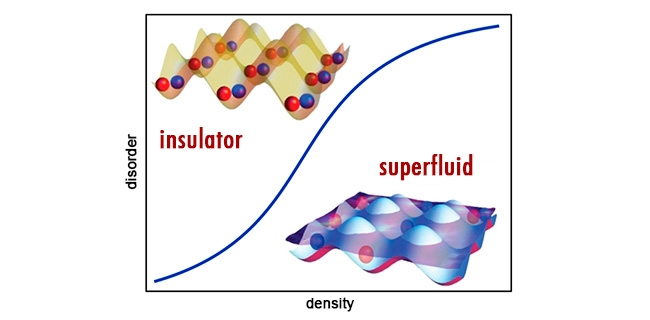


Brazilian researchers used a computer simulation to investigate the phenomenon. The study, published in Scientific Reports, could have technological applications in the future (image: researchers’ archive)
Published on 05/04/2021
By José Tadeu Arantes | Agência FAPESP – Classical phase transitions occur when certain parameters, such as temperature or pressure, vary. The best-known examples are water’s phase transitions from solid to liquid and from liquid to gas as temperature increases. Quantum phase transitions occur without a variation in these parameters. In contrast, the most noteworthy quantum phase transitions occur at stable temperatures, albeit extremely low temperatures near absolute zero, on the order of a few nanokelvin or even picokelvin.
Researchers affiliated with São Paulo State University (UNESP) at Araraquara in Brazil have performed a study designed to investigate a specific transition in which the material’s electrical conductivity changes radically, and instead of behaving as a superfluid or superconductor, the material becomes an insulator.
An article on the study, signed by Guilherme Arantes Canella and his PhD thesis advisor Vivian Vanessa França, is published in Scientific Reports as “Superfluid-insulator transition unambiguously detected by entanglement in one-dimensional disordered superfluids”.
The study was part of the project “Density functional theory and applications to solids and cold atom systems” led by França and supported by a Young Investigator grant from FAPESP.
“The transition was made possible by the creation of disorder via the inclusion of impurities in the material or random changes to the spacing between atoms,” França told Agência FAPESP.
The researchers used a computer simulation to increase the disorder and monitor the material’s responses. It is worth recalling that studies in this field comprise both basic science to understand the physical processes involved and applied science to make practical use of these transitions in creating new technologies.
“We designed one-dimensional chains and gradually added disorder to them,” França explained. “The first step entailed surmounting a major computational challenge. Disorder can’t be added to a specific site. If it were, it wouldn’t be random. Many possible configurations have to be simulated in order to find an average, and this requires a large amount of very complex calculations. The method that enabled us to crack this computational challenge was density functional theory.”
Density functional theory (DFT) is a simplified model derived from quantum mechanics that is used in solid-state physics and chemistry to resolve many-body systems (read more about DFT at: agencia.fapesp.br/32334).
“Even with the use of DFT, some 70 days of computer processing were needed to generate the points we present in the article,” França said. “Exact calculations, which are possible but much more time-consuming and costly, would take 115 years.”
França added that she and Canella worked on a generic material with certain considerations. “We simulated practically one-dimensional systems like nanowires comprising fermions and explored all possible parameters to investigate the superfluid-insulator phase transition,” she said.
Standard Model
Fermions can be thought of as the building blocks of matter, because atoms are made up of fermions. In the Standard Model, all particles are fermions or bosons. Fermions have odd half-integer spins and follow Fermi-Dirac statistics. Protons, electrons and neutrons are fermions. Bosons have integer spins and follow Bose-Einstein statistics. Photons and gluons are bosons. In Standard Model extensions that incorporate supersymmetry, every fermion has a boson partner and vice versa.
In the study led by França, the interaction among fermions is described by the one-dimensional Hubbard model. “What we found was that the transition can be obtained by varying three parameters: increasing the intensity of the impurities, increasing their concentration, or decreasing particle density,” she said.
Ordinary localization
An important question the study set out to answer was whether the quantum phase transition affected particle entanglement. Entanglement is the most exotic feature of quantum mechanics — the feature without any analogue in classical mechanics. Entangled states are states such that any change in one state is instantly reflected in the other state even if there is no spatial contiguity between them.
The preservation of entanglement as long as possible is key to the development of quantum computing. “Our study shows that all three variables [intensity of disorder, concentration of impurities, and particle density] affect entanglement,” França said. “We also confirmed that the transition can result in two kinds of insulator. As far as we know, this is something never reported before in the literature.”
“One of the characteristics of insulators is that the particles are well localized in the sample, in contrast with the delocalization of superconductors.” França said. “We observed what we call ‘ordinary localization’, in which the particles are localized but maintain a degree of delocalization because of the topology of the sample. As a result, entanglement is constant, as it should be in an insulator, but assumes a finite value different from zero. In what we call ‘full localization’, the particles are completely localized and no entanglement occurs.”
Many of the controversies recorded in the literature derive from the fact that the existence of these two kinds of insulators has not been considered. The authors were discussing different things, which led to contradictory results. Bringing this duality to light was an important contribution of the study.
“Ordinary localization occurs without the need for a minimal intensity of disorder. It’s associated with a less abrupt transition and can be achieved by means of any of the three parameters. Full localization requires minimal intensity and can only be achieved by means of the parameters concentration and density,” França said.
The article “Superfluid-insulator transition unambiguously detected by entanglement in one-dimensional disordered superfluids” (doi: 10.1038/s41598-019-51986-0) by G.A. Canella and V.V. França can be read at: www.nature.com/articles/s41598-019-51986-0.
To find out more about the research group or about master’s and PhD research opportunities in the field, go to: www.iq.unesp.br/#!/departamentos/fisico-quimica/docentes/vivian-v-franca.
Source: https://agencia.fapesp.br/32356